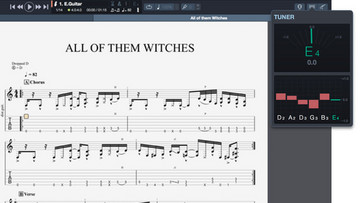

It’s written in all 16th notes, with a 32nd note flourish on every up beat (the “&” of a beat). The “Monkey Beat”, a term coined from Lamb of God drummer Chris Adler, is a quick beat, with a repeating kick and snare pattern throughout. Add or subtract more to get the sound you like. In the example here, since it’s initially written in 16th notes, the flourishes take the shape of 32nd notes. Basically, these are “fancy” quick feet patterns added into a straight pattern. The next example introduces what I call “flourishes”. The example in the lesson is written in half time (snare on beat 3) but like the initial set, that snare placement is your choice! Play around with the snare to get the feel you need. We then shift into typical metal beats Straight 16th notes blasting on double kick drums to start.

These work great for big sounding chorus sections of songs as well. Similarly to the initial set of beats, the slight move in snare placement changes the feel. The next two beats are typical standard and half time feel break down beats. Placing the snare on beat 3 of both 4/4 measures provides this laid back feel. Where a standard Rock beat may finish in one measure, with 4 total beats and the snare on 2 and 4, a half time beat would take 8 beats. Half time beats usually take up 2 measures to complete a phrase. The third beat is the half time feel, placing the snare on beat 3. This raises the energy of the song, giving the song an added push and, sometimes, build. This places a snare on beats 1,2,3 and 4. The second beat shifts the snare for a double time feel. This provides the listener with “stability” more or less, as it is very common to place snare hits here. A standard time feel for a rock beat in 4/4 would place the snare drum on beats 2 and 4 (as seen in the first beat). The first three beats are basic Rock beats. These can all be easily manipulated by simply copying and pasting different parts into your song, as well as adding or subtracting notes here and there. It then breaks into alterations of a beat. It is constructed in a way to first assist in understanding what a drum part can do to a song and provide a different feel.
#Guitar pro 6 vs 7 download
(click on the image to download the Guitar Pro 7 file ) Exercise Walk ThroughĪs a first lesson, I geared the beats toward simple Rock and Metal songs.
#Guitar pro 6 vs 7 how to
This Guitar Pro lesson is geared toward the singer/songwriter that doesn’t fully understand how to notate drums and wants to improve their songwriting workflow. Or maybe you need to explain to a drummer what ideas you may have for certain part but can’t physically show it yourself. Maybe you need to program your drum parts for your project. However, you may be in a situation where you don’t have a drummer yet. Usually the guitarist I’m working with will tab out their part, send it over for me to listen to, and then I add my drum parts to it. In the multiple bands I have been a part of over the years, Guitar Pro has been the center of our writing process. Musescore is free, and will convert notation to tab and vice versa.Download in this post, 13 drum beats to copy and paste into your Guitar Pro files.įor me, Guitar Pro has been a key tool in getting the ideas in my head down to “paper”. Is there a standard way to convert sheet music to guitar tabs? Https:///en - the world's most popular notation software. Bonus points if you actually do the notation in something like Musescore, but even if you just jot down the chord progression on a napkin, you'll be fine. On the export side, you can either print on paper/PDF or export out as a MIDI file.Īnd again given you know theory, why not just start composing? To start off with, you can use your brain and your guitar to help you come up with some chord progressions and melodic hooks, and then learn to accompany (or lead!) on the piano. The app is specifically made to write music and you can input either by typing/writing or by playing a MIDI keyboard.
#Guitar pro 6 vs 7 free
I would also take a look at MuseScore - Free & Open Source. You probably wouldn't need to bother with the entire piece, just those sections that are tricky and specific to the piece, like. I've added fingerings to my pieces and can usually finger a page in a minute or two. If you're up for learning a semi-complex piece of software, you can download the Musescore desktop app and then on, you can download the Musescore file, and add the fingerings in yourself.


 0 kommentar(er)
0 kommentar(er)
